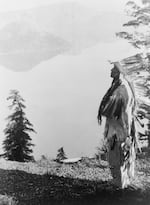
A Klamath Indian chief in a feather headdress stands on a mountain overlooking Crater Lake in 1923, long considered a sacred spot by local tribes. In 1902, the lake became a national park thanks to William Gladstone Steel, who for 17 years petitioned Congress to protect the natural wonder.
Edward S. Curtis / Library of Congress, 3c03070u
Each week Oregon Experience shares a photo highlighting the state’s diverse, exciting history.
Crater Lake was originally called Giiwas by the Klamath Indians, who considered it to be a place of sacred power. William Gladstone Steel first heard of the lake as a schoolboy in Kansas. He initially visited the lake in August 1885 and was awed by its beauty. Steel spent the next 17 years striving to have the area designated as a national park. He achieved his goal and was able to protect the lake and lands surrounding it for everyone's use.
Watch the Oregon Experience documentary “William Gladstone Steele” to learn more about Steele’s tireless effort to preserve Crater Lake.


This series is in partnership with The Oregon Historical Society